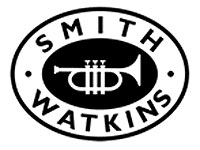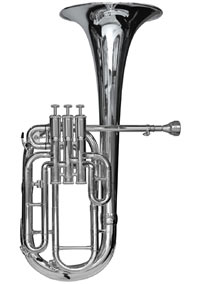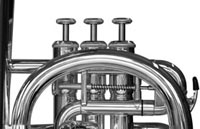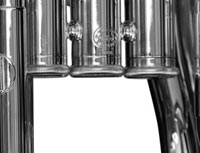4BR Roadtest: Smith Watkins Soloist tenor horn
7-Apr-20094BR has had its hands on the Smith Watkins Soloist tenor horn. Its certainly different, but does that mean that it does everything better?
 Introduction:
Introduction:
In pure design terms, variations on a theme are common enough – it’s the truly unique that make the head turn.
From the Lotus monocoque racing car to the Dyson vacuum cleaner, only rarely does someone come up with an unique design on a prescribed theme that makes you sit back, admire and think…
And think you do too – for this is musical engineering that wouldn’t be out of place in Formula 1, and is as revolutionary as Mr Dyson’s take on the humble domestic cleaner.
It is also the response most people tend to experience when they first come across brass instruments from Smith-Watkins.
There is little doubting the standard of technical engineering that goes into their making, the quality of the materials they use in their construction, or what they actually sound like in the hands of very good players.
It’s just the idea behind – ‘sound’ principles so to speak – a pursuit to overcome problems of resonance and power output through ongoing leadpipe and bell development .
As the company motto suggests, their instruments are built very much with the individual in mind.
For a long time designer Richard Smith has worked towards producing instruments that meet those very specific requirements – so much so that the Smith-Watkins cornets come with up to nine interchangeable leadpipes.
Now those same principles have been used to create his ‘Soloist’ tenor horn.
4BR has had its hands on the instrument for a couple of weeks, and have asked a number of players to give it a rigourous work out. We have asked for their opinions and their thoughts in four main areas: Build Quality/Design; Intonation; Ease of Blowing/Tone and Overall performance/Value for Money.
Marks are out of 25.
So this is what we thought…
 Build Quality/Design:
Build Quality/Design:
The most immediate thing to strike you is the design of the model – think the humble Hoover versus that Dyson cleaner.
Unlike every other tenor in the world (unless there is one produced in Outer Mongolia) the design is unique, but strangely in a tenor horn world of Angelina Jolie curvaciousness, the S/W is a bit of a Sarah Jessica Parker – all a little more angular.
It’s that straight leadpipe that is the striking asthetic feature of course, but there are other subtle features that make it cleaner looking too (and we are not talking Mrs Pitt’s penchant for tattoos here either). You wouldn’t say it’s the prettiest thing, but it has a persuasive attractiveness.
As for build quality – second to none it must be said.
The craftsmanship on show is outstanding, an instrument put together with with hand made precision and attention to detail that would make Rolls Royce green with envy. Every last bit and bob is fine tuned to near perfection – and not a single bit of ‘bling’ gold to be seen for love nor money.
Valves are excellent, slides beautifully grooved into place, the instrument furniture little works or art, the finish gleams. Pick it up and it feels balanced and made for its purpose in life.
That sense of engineering precision also makes for the other striking feature on the instrument – the trigger mechanism.
As you would expect, it is engineered quite beautifully – simple yet effective, linked to the desire not to sully the initial aim of not disturbing the uninterrupted column of air down the leadpipe.
 Different approach
Different approach
It is however, a totally different approach to that found on the likes of the York and Besson – the two top end instruments used in bands at the moment.
And that may be its Achilles Heel – for it takes a bit of getting used to (you use the thumb of the right hand), and also means that the modern tenor horn player (who holds the instrument in the left hand around the valve block) will find the instrument tricky to clasp comfortably too.
Much as the mechanism works for its purpose (see right) , it does seem to be a perfect engineering answer to a rather more obscure musically inspired question – one that brass band players in particular would tend to think uneceesary for their needs.
Overall: The build quality is by far the best we have come across – a hand made instrument with craftsmanship of excellence that is hard to fault.
The design of the trigger mechanism is more debatable – a perfect piece of engineering problem solving, but one that makes the instrument difficult to handle with absolute comfort.
MARKS: 22/25
Intonation:
Once our guinea pigs had got used to the trigger mechanism, there were few complaints about the instrument’s ability and intonation characteristics.
Throughout the entire range the instrument rang true – from the leviathan depths below the stave to the ear splitting reaches of the stratosphere.
Judicious use if the trigger was beneficial (if again, a little tricky) and the S/W held its integrity at both ends of the dynamic spectrum. Give it welly and it still stayed in tune, reduce the flow and it was remarkably clearly centered and true.
Tricky notes such as top G and A above the stave needed very little help, whilst the multiple valve combinations at the lower end of the scale were pliable.
Very impressive for our test drivers – just that fiddly old trigger meaning that some said they would still consider using the lip to get some notes in tune if needed.
Overall: More impressive results throughout the dynamice and scalic range, but that fiddly trigger isn’t the 100% alternative answer for everyone it seems. (There is a slightly cheaper version of the instrument without the tuning shunt mechanism called the 'Artiste'.)
MARKS: 23/25
Ease of Blowing/Tone:
The real strength of the S/W comes with the ability for the player to have the choice of up to 5 interchangeable leadpipes to suit their needs.
This in turn allows the performer to tailor the instrument to meet his or hers requirements, not just in general terms but even to those on an indivdual piece of music.
Pick the one that suits you best and the result is impressive to say the least. Allied to the instruments bore size of .470" (the York is .468" and the Besson .409") and bell diameter of 203mm (same as the York and Besson) it gives the instrument a remarkable elasticity throughout the dynamic range.
It can take just anything you can throw at it in fact, and still have room for more, whilst the tone is authentically darkly hued, well rounded and secure.
A top class player can manipulate the sound easily (the interchangeable leadpipes help of course) but there is ample scope to mould the sound to accommodate orchestral style playing or good old fashioned brass band output.
Overall: Top end stuff once more. The choice of leadpipe is important however, but once a high quality player has made the choice they are most suited to, then there is plenty of scope to experiment.
MARKS: 24/25
 Overall Performance/Value for Money:
Overall Performance/Value for Money:
Now comes the crux.
The S/W isn’t cheap – with VAT it will make a hefty hole in your credit crunched pocket of £2,652.92, whilst the interchangeable leadpipes are an extra £235.92 a pop.
You don’t get a mouthpiece, lyre, any valve oil or goody bag extras either, although the case it comes in does ( and is some weight and made to withstand a nuclear attack). You are talking well over three grand here.
Given that the Besson Prestige can be picked up for around £2,500 and the York £2,200, whilst the old Yamaha Maestro comes in at approximatley £1,750 then you can see why you don’t see many around at this time in the musical economic cycle.
What you do get for your money though is a tenor horn that has perhaps been designed for a very select band of customer – professional players with very professional needs.
If you are one of those, and want something that exudes the same type of quality as you do as a performer then you can’t get better.
It is a very small market however.
The overall performance plus points are huge – superbly engineered, blows like a dream, is pliable and elastic in the right hands, and can be moulded to suit very specific musical needs.
It is an acquired taste however – the trigger mechanism takes some getting used to and means that brass band players would find it all a little impractical to use on a day to day basis in a banding environment. Imagine your average second horn player trying to use it day in day out – they would get RSI of the right thumb.
Overall: It is what it is – a very exclusive instrument for a very exclusive type of player. That is both its strength and weakness then.
MARKS: 22/25
Overall comment:
If you have the money to go with your talent as a high class tenor horn solo performer, and the desire to have an instrument that certainly does everything you ask of it, then go out and invest in a Smith-Watkins.
If though you don’t have the dosh, are not quite the very tip top solo performer and require an instrument that is more suited to the workhorse environment of the modern brass band – then the Smith-Watkin is not for you.
Be realistic though.
Overall Total:
Build Quality and Design: 22 points
Intonation: 23 points
Ease of Blowing and Tonal quality: 24 points
Overall performance and value for money: 22 points
Overall Score: 91 points
 Specifications:
Specifications:
Cost: See above
Instrument specifications
The tenor horn has the following features:
· Pitch: E
· Bore: 11.75mm (.470")
· Bell Diameter: 203mm (7.99")
· Choice of 5 straight interchangeable leadpipes
· Length: 525mm
· Weight: 1.74kg
· Top sprung Monel® pistons resist corrosion
· Brass valve guides give positive valve action
http://www.smithwatkins.com/









